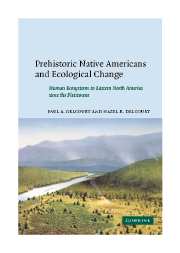 Prehistoric Native Americans and Ecological Change
Prehistoric Native Americans and Ecological Change 3 - Holocene human ecosystems
Published online by Cambridge University Press: 30 October 2009
Summary
Panarchy theory provides a means of integrating ecosystem theory with sociology to explain the development of human ecosystems as complex adaptive systems. Panarchy theory views the complex interactions between humans and their environment as adaptive responses that result in self-organized, hierarchical systems. Human ecosystems are distinguished by the ability of people to use foresight, perform intentional actions, communicate ideas and experience, and make technological innovations. Currently, panarchy theory is applied primarily to issues of biological sustainability relevant to the present millennium (Gunderson and Holling, 2001).
Quaternary scientists and archaeologists examine environmental, ecological, and cultural changes on a variety of spatial and temporal scales. Panarchy theory is a powerful heuristic model that can provide a contemporary explanatory framework for integrating paleoecological and archaeological data over a nested series of hierarchical levels. This perspective provides a new paradigm for interpreting multiple forms of evidence concerning the processes that have underlain the development of late-Quaternary human ecosystems.
Humans have interacted with their environment since their arrival on the North American continent some 15 000 calendar years before present (BP, where 0 BP is equivalent to AD 1955, based on CALIB 4.3 calibration of radiocarbon ages; Stuiver et al., 1998). The degree to which the actions of human beings resulted in ecological change has been determined by many factors, including human population size, lifeways, and the susceptibility of natural landscapes to anthropogenic alteration (Delcourt, 2002). We propose the following set of premises upon which to build a contemporary bridge between paleoecology and archaeology:
In the late Pleistocene and Holocene, Homo sapiens played an important ecological role as a keystone species, and prehistoric Native Americans had their own organism-centered view of landscapes and capability of ecological interaction and manipulation (O'Neill, 2001).
[…]
- Type
- Chapter
- Information
- Prehistoric Native Americans and Ecological ChangeHuman Ecosystems in Eastern North America since the Pleistocene, pp. 18 - 32Publisher: Cambridge University PressPrint publication year: 2004
